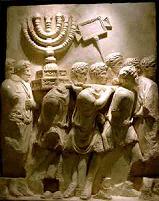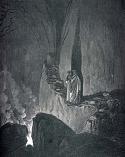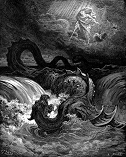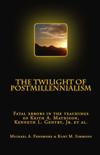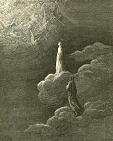Why the Single Millennium Model Forces
a Futurist Eschatology
by
Kurt M. Simmons
The imagery of Revelation twenty is probably the most difficult in the Bible. Central to its imagery is the enigmatic “millennium.” Whole schools of eschatology have grown up around the millennium, which attempt to explain its meaning and relation to the second coming of Christ. Pre-, Post-, and A- millennialism each hold that a single millennium is contemplated by the text. Not coincidentally, each is also a futurist school of eschatology. What is the connection between these? Is there something inherent in the single millennium model that makes it a logical corollary of futurist eschatology? The purpose of this article will be to demonstrate that, in fact, there is a connection between the single millennium model and futurist eschatology, and that Preterists must adopt a Bimillennial interpretation of Revelation twenty to avoid internal inconsistency in their eschatological scheme.
Basic Interpretative Approaches
There are two basic approaches to Revelation twenty. These see the images as either 1) literal and chronologically progressive, or 2) symbolic and recapitulatory. Premillennialism is an example of the first sort in that it sees a literal thousand years in Revelation twenty’s imagery, which it places after the destruction of the beast, the kings of the earth, and false prophet in chapter nineteen. Thus, the events depicted in chapter twenty are progressive in that they follow those of chapter nineteen, literal in that they foretell the actual duration of the events described; viz., a thousand years. On the other hand, Preterism belongs to the symbolic and recapitulatory school. Recapitulatory, in that it views the images of chapter twenty, not as sequential to, but synchronous with those of chapter nineteen, describing under different symbols events variously portrayed elsewhere in the book; symbolical, in that the “thousand years” do not entail a literal duration of time. A third approach combines these, marrying symbolic with chronological progression. Certain schools of Amillennialism offer an example of this approach in that they interpret the millennium as a symbol for a period of indefinite length and duration concluding at the world’s end, but beginning after destruction of the beast, the kings of the earth, and false prophet in chapter nineteen. Foy E. Wallace Jr. is among this latter class, viewing the events of the Apocalypse through chapter nineteen as speaking to the persecution under Nero and the destruction of Jerusalem, but chapter twenty as surveying world history until the end, the battle of Gog and Magog as symbolic of the church’s struggle against various forms of world paganism throughout remaining time:
“After the catastrophic fall of Judaism, and the victory of the saints over the imperial persecutors, there was a renewed struggle of the church with heathenism, a spiritual conflict symbolized by Satan being loosed out of his prison. With Judaism removed from the path of the church, and the cessation of persecution by the imperial rulers, the way was opened for the expansion of Christianity, as foretold by Jesus in Matt. 24:31, and envisioned by John in Rev. 11:15. But it was not without opposition – the remaining enemy was heathenism. Satan’s theatre of activity in this struggle was not persecution, but spiritual and doctrinal: And shall go out to deceive the nations which are in the four corners of the earth – 20:8…This part of the vision was descriptive of the battle with heathenism, hence the reference to Gog and Magog…the mythical ruler of heathendom…As the beast was symbolic of the Roman empire, personified in the persecuting emperors, so was the Gog and Magog personification symbolic of the spiritual forces of heathenism launched against the church in the “battle” of verse eight…” (Foy E. Wallace Jr, The Book of Revelation (Foy E. Wallace Publications, 1966), pp. 417, 418)
We survey these schools to acquaint the reader with the basic issues facing interpretation of Revelation twenty and to help point out why a Bimillennial approach is necessary for Preterists to interpret the chapter consistent with a past-fulfillment perspective. For, as we shall see, the single millennium approach is the bed-fellow of futurist eschatology.
The Problem Stated
As suggested by Wallace’s comments above, futurism creeps into the text surrounding interpretation of the millennium and the battle of Gog and Magog. The single millennium model forces the reader to adopt a futurist eschatology because the reign of the martyrs who die under the beast is followed by yet another contest prior to the second coming of Christ. The fact that the martyrs die under the beast (Rev. 20:4), a symbol universally associated by Preterists with the persecution under Nero Caesar, establishes the historical referent of the martyrs’ deaths, tying them to the first century. This is also shown by the fact they are beheaded (v. 4), a Roman form of execution. The persecution under Nero was to be the final crisis before the eschaton. It was to prepare the saints against the coming storm of persecution under the beast that the book of Revelation was written. But by wedding the martyrs’ reign to the binding of the dragon, the battle of Gog and Magog is made to follow the reign of the saints, thus creating a “second” final contest the saints must endure before the end. Since there is no historical referent between the persecution under Nero Caesar and the destruction of Jerusalem in A.D. 70 that this contest can conceivably point to, the reader is logically driven to the conclusion that the events depicted by the millennium and the battle of Gog and Magog are not yet fulfilled. The number of commentators who make this blunder is legion. Terry’s analysis is typical:
“At the end of the millennial period there is to be a loosing of Satan, a rising of hostile forces, symbolized by Gog and Magag (comp. Ezek. xxxviii, xxxix), and a fearful catastrophe, resulting in the final and everlasting overthrow of the devil – the culmination of the prophecy of Gen. iii, 15. This last conflict, belonging to a distant future, is rapidly passed over by the seer, and its details are not made know (verses 7-10). (Milton S. Terry, Biblical Hermeneutics (Hunt & Eason, 1890, reprinted Wipf & Stock Publishers, 1999), p. 376)
Others falling into this “trap-for-the-unwary” include Chilton and Russell.[1] Perceiving the necessity of a pre- A.D. 70 historical referent for Gog and Magog, Max King seeks to solve the dilemma by offering that Gog and Magog represents the revolt of the Jews from Rome, an unsatisfactory explanation if ever there was one:
“Thus, instead of Gog and Magog representing Gentile forces, they symbolize heathen Israel in her final opposition to the church…But in what way could it be said that national Israel compassed the camp of the saints about, and the beloved city, or new Jerusalem? Since their power to persecute was destroyed, this final battle was evidently an effort on the part of Israel to establish her claims as the true Israel of God, and to show that she was the queen and no widow (18:7). She would now destroy the church by establishing herself in Palestine as a power of world renown. To accomplish this, she set out to throw off the Roman yoke.” (Max R. King, The Spirit of Prophecy (Warren, OH, 1971), p. 353)
The problem with King’s analysis is that it totally fails to answer the description of the battle of Gog and Magog in either Ezekiel or Revelation, both of which depict it as an attack upon the church, not a revolt from Rome. (Cf. Ezek. 38, 39) Moreover, how the Jews could destroy the church by establishing themselves as a power merely in Palestine is not explained. For that matter, can anyone really believe that the men who prosecuted the war against Rome - Eleazar, who was over the Zealots, John of Gischala, who was over the Galileans, and Simon, who was over the Idumeans – men who were the worst sort of criminals and tyrants, had any religious scruples about the church? Clearly, it was not to destroy the church that the Jews revolted from Rome, but to secure national liberation. In offering this explanation, King is simply grasping at straws. Still, King’s analysis serves to underscore the dilemma created by the single millennium approach to Rev. 20:1-10 and the battle of Gog and Magog.
Recapitulation and the Battle of Gog and Magog
One part of the solution to the battle of Gog and Magog lies in recognizing the fact that numerous times Revelation retraces its steps to cover different aspects of previous passages and events under new symbols. Thus, the four horsemen of the Apocalypse in chapter six are depicted as the four winds of heaven restrained in Rev. 7:1, but loosed in chapters eight and nine. The plagues in chapters eight and sixteen are not new plagues, but expansions upon the plagues under the horsemen in chapter six. And the great day of the Lord in Rev. 6:17 is the same as the great day of God Almighty in Rev. 16:14. In the same way, Gog and Magog are not a second final battle the saints were to face before the end, it was the final battle. One writer puts it this way:
“In 16:14 kings are called forth to the battle. In 19:19 the beast and kings of the earth come forth to the battle. In 20:8 Satan leads his host up to the battle. It seems clear that these three texts describe not three battles but one. The new point revealed in 20:8 (because Revelation never repeats itself merely for the sake of repetition; something new is revealed each time) is what happens to Satan as a result of this battle. Chapt 19 records what will happen to the beast and the false prophet as a result o their defeat in this battle. Here in 20:10 we learn what will happen to Satan.” (Robert B. Strimple, Three Views on the Millennium and Beyond (Zondervan, 1999), p. 125.)
In other words, the images of Rev. 20:1-10 are not progressive, but a recapitulation. There were not three end-time battles, but one; the battle of Gog and Magog is the same battle described elsewhere in Revelation under different symbols. In Rev. 16:14-16, the dragon, beast, and false prophet marshal their forces to the battle of Armageddon. In Rev. 19:17-21, the battle ends with the destruction of the beast and false prophet. (vv. 19, 20) The imagery of the battle is drawn from the battle of Gog and Magog. (Ezek. 39:17 et seq.) This establishes the identity of Armageddon and Gog and Magog; it also establishes the identity of Gog and Magog with the beast and false prophet. The beast is universally recognized in Preterist circles with the persecution under Nero Caesar. Nero’s name adds up to six hundred, three score and six in Hebrew and he was the sixth emperor reigning when Revelation was penned. (Rev. 13:18; 17:10) Since the beast and false prophet perish in the battle of Gog and Magog (Rev. 19:19-21), it is clear that this battle is a symbol for the spiritual contest of Nero and the Jews against Christ and the church. Thus, rather than falling into the trap of futurism by seeing the battle of Gog and Magog as a yet-to-be-fulfilled contest, we find instead the Neronean persecution clothed in other garments. (Actually, the symbolism is not new; reference to Gog and Magog in Rev. 20:8 only appears new. Most commentators fail to notice that the imagery of Rev. 19:17 et seq., is taken from Ezekiel's description of Gog and Magog and, therefore, fail to notice the identity of these battles. It is this fact leads them to see Gog and Magog as progressive, rather than recapitulatory.)
Thus far, identifying the battle of Gog and Magog with the persecution under Nero is pretty simple and straight forward. However, when the millennium is thrown into the mix difficulties arise. Under the single millennium approach, Gog and Magog follow the martyr’s reign. However, since the martyrs died under the beast, a problem immediately arises. How can Gog and Magog be the persecution under Nero if it follows martyrdom of the saints? Clearly, in order to be the Neronean persecution, Gog and Magog must precede, not follow, the deaths of the saints. However, by marrying the reign of the martyrs to the binding of the dragon, Gog and Magog is wrested from its historical position and made to follow the deaths it actually caused! This is why many commentators, who otherwise see a first century context to Revelation, find themselves forced into the futurist model: Since the historical referent of the martyrs’ death under the beast is fixed and certain, there is no other way to account for Gog and Magog except to see it as another, future contest of the church. Thus, by wedding the reign of the saints to the internment of the dragon the door to recapitulation is closed. However, rather than throw out the recapitulatory model, the answer is to unwed the binding of the dragon and the reign of the saints and adopt a bi-millennial approach.
Two Millennia Necessary for Recapitulation
If the single millennium model closes the door to recapitulation, the two millennia model opens it. In fact, without two millennia there can be no recapitulation – Gog and Magog must forever remain a second final battle the saints were to face before the end – a battle about which scripture and history are both perfectly silent. When the binding of the dragon and the reign of the saints are chronologically wed, the battle of Gog and Magog follows the martyrdom and reign of the saints. (Rev. 20:4-8) This is because the battle follows the loosing of the dragon after its thousand-year imprisonment. (vv. 7, 8) But when the reign of the saints and binding of the dragon are treated as separate events, then the martyrdom and reign of the saints are allowed to assume whatever place the application of exegetical principles assigns - viz., they will follow the battle of Gog and Magog rather than precede it. This is also true of Gog and Magog. When wed to the reign of the saints, Gog and Magog is forced into a futurist position as a second final contest before the eschaton. However, by divorcing the reign of the saints from the binding of the dragon, the battle of Gog and Magog may assume its proper place in the scripture’s eschatological scheme - viz., it will precede the reign of the martyrs rather than follow it.
Why does John insert the reign of the saints in the midst of his narration about the binding and loosing of the dragon? For that matter, assuming that the battle of Gog and Magog is the persecution under the beast, why is the reign of the martyrs seemingly portrayed before the battle in which they die? The recapitulatory nature of the passage again must be borne in mind. The internment of the dragon has previously been alluded to by John under other symbols; viz., the beast from the bottomless pit (Rev. 11:7); the mortal wound to the beast’s head (Rev. 13:3); the beast that “was and is not and shall ascend out of the bottomless pit” (Rev. 17:8); and the earth swallowing the dragon’s flood. (Rev. 12:16) The binding of the dragon is a parenthetical description of the events following the deadly wound to the beast's head, when it went down into the bottomless pit upon the collapse of the persecution that arose over Stephen. (Acts 7, 8; Rev. 12) In presenting the imagery of the dragon being bound, John is retracing his steps to present familiar themes under new symbols. What is new in chapter twenty is not the dragon’s binding, but his defeat. The binding of the dragon is merely a brief recap of what has gone before to refresh our recollection and to set the stage for the dragon’s ultimate destruction.
The reign of the martyrs has also previously been alluded to. In Rev. 14:9-13, the blessed state of the martyrs is mentioned, saying, “If any man worship the beast and his image, and receive his mark in his forehead, or in his hand, the same shall drink of the wine of the wrath of God, which is poured out without mixture…Here is the patience of the saints: here are they that keep the commandment of God, and the faith of Jesus. And I heard a voice from heaven saying unto me, Write, Blessed are the dead which die in the Lord from henceforth: Yea, saith the Spirit, that they may rest from their labours; and their works do follow them.” (Cf. Rev. 6:9-11) Those mentioned here are the same individuals portrayed in Rev. 20:4-6 as having won the martyr’s crown. Their deaths under the dragon, beast, and false prophet are not a defeat, but a victory. They have overcome and are sit down with Christ in his throne. (Rev. 2:26, 27; 3:20, 21) Their appearance in Rev. 20 is merely parenthetical and shows that, while God is preparing the destruction of the dragon, the martyrs are safely and tenderly gathered to rest. The purpose of the passage is to instill courage in those that will suffer torture and death for Christ. It is similar to Paul’s words to the Thessalonians: “But I would not have you to be ignorant, brethren, concerning them which are asleep, that ye sorrow not, even as others with have no hope.” (I Thess. 4:13) Hence, Rev. 20:4-6 is a window into the blessed estate of the martyrs in Hades alluded to in Rev. 14:9-13, and nothing more. What is new in chapter twenty is not the reign of the martyrs, so much as the general resurrection that follows the battle of Gog and Magog and the dragon's demise. The salient features of Rev. 20 may be stated thus:
|
Dragon's Internment Persecution that arose over Stephen - Internment in Tartarus (Temporary Cessation of Persecution) - Gog and Magog (Neronean Persecution) - Destruction and Defeat at Christ's Coming
|
Reign of the Saints Neronean Persecution - Reign in Paradise - General Resurrection at Christ's Coming
|
|
Thus, the recapitulatory nature of Rev. 20: 1-10 and the fact of two millennia are easily seen. Hence, it is a question of either a single millennium, progression, and futurism, or two millennia, recapitulation, and Preterism. There is no third alternative.
Other Indicia of Two Millennia
Of course, allowing Gog and Magog to assume its proper historical place is not the only reason for opting for a Bimillennial approach. Other factors point to two millennia. The “thousand years” speaks to the timelessness of the Hadean realm, the place of departed spirits. The dragon is interred a “thousand years” in tartarus (the bottomless pit), and the martyrs reign a “thousand years” in paradise with Christ. This reign is called the “first resurrection.” The first resurrection is real; the souls of the saved were tenderly received by God into paradise. Paradise is also called “Abraham’s bosom” and the “third heaven.” (Lk. 16:22; 24:43; II Cor. 12:2-4) However, whereas the reign of the saint is actual, the binding of the dragon is merely symbolic. We would submit that it portrays God’s providential binding of the world civil power during the period between the persecution that arose over Stephen and the persecution under Nero, when Claudius Caesar restrained the Jews and Romans from persecuting the church. After Claudius’ death, Nero came to the throne and the “man of sin” and "son of perdition" was revealed (II Thess. 2: 3, 8) and the first imperial persecution begun. Because the binding of the dragon is merely symbolic, whereas the first resurrection was real, it is clear that they cannot be same “thousand years.”
That there are two separate thousand-year periods contemplated by the text is also seen in the fact that there are two resurrections. The dragon’s thousand-year internment ends when it is released to persecute the saints (v. 7; cf. Rev. 11:7; 17:8), but the thousand-year reign of the martyrs yields only to its eternal reign with Christ at the general resurrection when death and hades are destroyed. (Rev. 20:14) The resurrection of the dragon occurs before the general resurrection, viz., in A.D. 64 when the Neronean persecution began. The resurrection of the saints and martyrs did not occur until as late as A.D. 70. Christ consumed Nero with the brightness of his coming and breath of his mouth (II Thess. 2:8), but the way into the holiest (heaven) was not open until the plagues of the seven angels were fulfilled. (Rev. 15:8) Hence, there was a short period between the persecution and the resurrection when the souls of the martyrs rested in Hades. (Cf. Rev. 6:9-11) Since the different actors each received a different “resurrection” at different times there cannot be a single thousand-year period between them.
Third, there is the grammatical structure of the passage. The definite article (“the”) is referential and assumes a prior familiarity with its subject. The Greek has no indefinite article (“a”); where the noun has no article the English language supplies it. Unlike the definite article, which is referential, the indefinite article introduces a new subject. Thus, when John first introduces the symbol of the dragon’s binding he uses the indefinite article: “And I saw an angel come down from heaven, having the key of the bottomless pit and a great chain in his hand. And he laid hold on the dragon, that old serpent, which is the Devil and Satan, and bound him a thousand years.” (Rev. 20:1, 2) Notice that the indefinite article “a” introduces for the first time the symbol of a thousand years. Subsequent reference to this thousand years is always prefaced by the definite article “the.” “And cast him into the bottomless pit, and shut him up, and set a seal upon him, that he should deceive the nations no more, till the thousand years should be fulfilled: and after that he must be loosed a little season.” (v. 3; emphasis added.)
Here, the definite article assumes a prior familiarity with the thousand years. Its function is referential, it points back to the thousand years introduced in verse two. However, when John reaches verse four, we do not find the definite article, but the indefinite article. “And I saw the souls of them that were beheaded for the word of God…and they lived and reigned a thousand years.” (Emphasis added.) The indefinite article here indicates that a new subject is under discussion, another thousand years. Had this been the same thousand years of the dragon’s binding, John would have said “And I saw the souls of them that were beheaded for the word of God…and they lived and reigned the thousand years.” However, by use of the indefinite article we may be certain another thousand-year period is introduced. Other examples of this pattern occur throughout Revelation. (Cf. Rev. 12:3, 4 with Rev. 13:11 – the great red dragon with “a dragon”; Rev. 8:10, 11 with Rev. 91 – the star nominated “wormwood” with a star nominated “Abaddon” showing different dragons and stars are signified.)
Finally, another factor pointing to two millennia is John's use of the phrase "and I saw" (Gk. kai eidon) in Rev. 20:1, 4. Use of this phrase, or its literary equivalent "and I heard," typically points to a new vision and subject. Review of a few instances where these phrases occur will demonstrate the truth of this statement. (Cf. Rev. 14:1; 15:1; 16:1; 17:3; 18:1, 19:11; 20:1, 4, 11) Thus, when in verse four John states "And I saw thrones and I saw the souls of them that were beheaded for the witness of Jesus," etc., he leaves the binding of the dragon and introduces a new subject. This new subject includes another thousand years. As already noted, this is also shown by the indefinite article ("a") - "and they lived and reigned with Christ a thousand years." "And I saw" points to a new vision and subject, the indefinite article points to another thousand years. Together, they show that the historical circumstances symbolized by the binding of the dragon are no longer in view.
Thus, quite apart from the exegetical necessity of allowing the persecution under Nero to assume its place as the final contest the saints had to endure before the eschaton, there are other indicia pointing to two millennia, both grammatical and exegetical. Together, they present an insurmountable case that two millennia are contemplated by the text. (For additional argument for two millennia, see the author's book The Consummation of the Ages.)
Conclusion
The single millennium model forces a futurist eschatology by creating a second final contest the saints were required to face before the eschaton. By wedding the reign of the martyrs to the binding of the dragon, Gog and Magog is forced from its historical place as the persecution under Nero and the beast and made to follow it instead. Only by divorcing the binding of the dragon from the reign of the saints and martyrs can the trap of futurism be avoided and Gog and Magog allowed to assume its proper place as the last conflict before the end. It is a question of either a single millennium, progression, and futurism, or two millennia, recapitulation, and Preterism. For Preterists the choice should be easy.
Notes:
[1] “The specific point of the binding of the Dragon, therefore, is to prevent him from inciting the eschatological “war to end all wars,” the final battle – until God is ready. When God’s Kingdom-City is fully matured, then He will once more release Satan and allow him to deceive the nations for the final conflagration.” (David Chilton, Days of Vengeance, pp. 506.)
“We must consequently regard this prediction of the loosing of Satan, and the events which follow, as still future, and therefore unfulfilled. We know of nothing recorded in the history which can be adduced as in any way a probable fulfillment of this prophecy…The result of the whole is, that we must consider the passage which treats of the thousand years, from ver. 5 to ver. 10, as an intercalation or parenthesis. The Seer, having begun to relate the judgment of the dragon, passes in ver. 7 out of the apocalyptic limits to conclude what he had to say respecting the final punishment of the ‘old serpent,’ and the fate that awaited him at the close of a lengthened period called ‘a thousand years.’ This we believe to be the sole instance in the whole book of a excursion into distant futurity; and we are disposed to regard the whole parenthesis as relating to matters still future and unfulfilled.” (J. Stuart Russell, The Parousia (1887, T. Fisher Unwin, London; Republished 1983, 1999, Baker Books, Grand Rapids), pp. 522, 523.)
To receive Kurt Simmons’ e-mail newsletter, The Sword & The Plow, click the Subscribe link:
All rights reserved.
